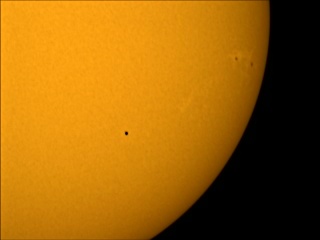
The black dot visible on the face of the Sun is the planet Mercury during the transit on November 8, 2006. At intervals of about 13 or 14 times a century, we get to see Mercury cross in front of the Sun at inferior conjunction. Transits of Mercury only occur in November or May, because of the way that Earth's orbit is aligned relative to the orbit of Mercury. A transit can only be observed from a particular location on Earth if the event occurs during daylight hours while the Sun is visible. The transit of Mercury on May 7, 2003, was visible only from Europe, Africa and the Middle East. The grazing transit of Mercury on November 15, 1999, was visible from North America. During that grazing transit, the planet's path moved across the edge of the northeastern limb of the Sun, barely crossing in front of the Sun.
Compare the size of Mercury in this transit image with the size of Venus during a transit of Venus. A transit of Venus is a rare event. Venus transits occur in pairs spaced 8 years apart. But then more than 100 years will go by before another transit of Venus occurs.
Mercury is an inferior planet, meaning it's orbit lies inside our orbit. The inferior planets show phases, i.e., changes in their apparent shapes, like the moon as they move about the sun. At inferior conjunction, the phase of Mercury is similar to the "new moon" phase of the moon. Venus is also an inferior planet and shows phases.
This image was taken with a ToUCam webcam on a Takahashi FS-78 refractor. The HandyAVI 2.0 software program was used to control the webcam. A solar filter was used over the front of the telescope.
November 8, 2006
Image by Sid Leach
Scottsdale, Arizona
Recent Images.
Complete list of images.
Description of equipment used to acquire images.
Home
Feedback and comments should go to Sid